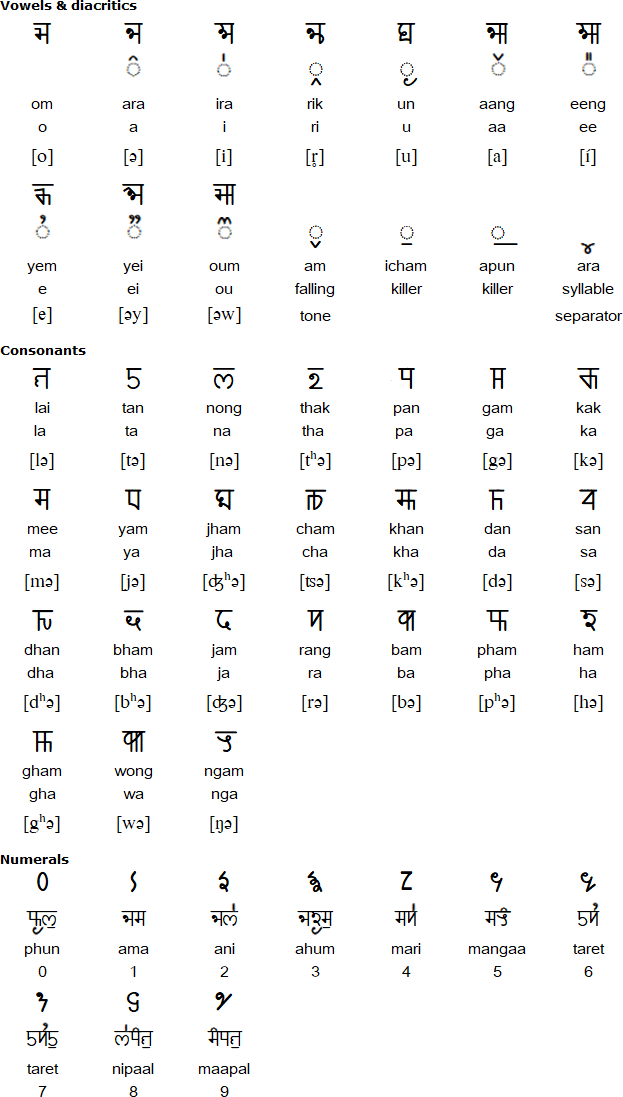Meetei Yelhou Mayek is an old script for Manipuri, a member of the Kuki-Chin-Naga branch of the Tibeto-Burman language family spoken in Manipur and Assam in the northeast of India.
It was revived in the 1930s by Laininghan (Prophet) Naoriya Phulo (1888-1941), a Meitei religious, social and political leader, who founded a Meitei religion revivalist school called Apokpa Marup in Assam. He called the script Meetei Yelhou Mayek. It is also known as Naoriya Phulo script or the Naoria script
The are seven Meitei clans (sagei). The head of each Sagei Pibas, used bronze coins (laisen) for their rituals. The coins had inscriptions on them in an old script. Naoriya Phulo used the inscriptions as the basis for a script which he called Meetei Yelhou Mayek ("Meeitei Indigenous Script"), and which he used to rewrite holy texts.
Followers of the Apokpa Laining faith continue to use Meetei Yelhou Mayek in their religious texts, and teach the script in religious schools and temples. There are also some other books in the script, and a newspaper.
Some sources argue that Naoriya Phulo created the script, rather than reviving an old script.


Some information about the Meetei Yelhou Mayek script provided by Biswajit Mandal
Information about Manipuri | Manpuri script (Modern) | Manpuri script (Old) | Meetei Yelhou Mayek | Phrases | Numbers
Information about Meetei Yelhou Mayek
https://en.wikipedia.org/wiki/Naoriya_Phulo_script
https://www.endangeredalphabets.net/meetei-yelhou-mayek/
https://www.endangeredalphabets.net/naoriya-phulo/
Ahom, Aima, Arleng, Badagu, Badlit, Basahan, Balinese, Balti-A, Balti-B, Batak, Baybayin, Bengali, Bhaiksuki, Bhujimol, Bilang-bilang, Bima, Blackfoot, Brahmi, Buhid, Burmese, Carrier, Chakma, Cham, Cree, Dehong Dai, Devanagari, Dham Lipi, Dhankari / Sirmauri, Ditema, Dives Akuru, Dogra, Ethiopic, Evēla Akuru, Fox, Fraser, Gond, Goykanadi, Grantha, Gujarati, Gunjala Gondi, Gupta, Gurmukhi, Halbi Lipi, Hanifi, Hanuno'o, Hočąk, Ibalnan, Incung, Inuktitut, Jaunsari Takri, Javanese, Kaithi, Kadamba, Kamarupi, Kannada, Kawi, Kharosthi, Khema, Khe Prih, Khmer, Khojki, Khudabadi, Kirat Rai, Kōchi, Kodava Lipi, Komering, Kulitan, Kurukh Banna, Lampung, Lanna, Lao, Lepcha, Limbu, Lontara/Makasar, Lota Ende, Magar Akkha, Mahajani, Malayalam, Meitei (Modern), Manpuri (Old), Marchen, Meetei Yelhou Mayek, Meroïtic, Masarm Gondi, Modi, Mon, Mongolian Horizontal Square Script, Multani, Nandinagari, Newa, New Tai Lue, Ojibwe, Odia, Ogan, Pahawh Hmong, Pallava, Phags-pa, Purva Licchavi, Qiang / Rma, Ranjana, Rejang (Kaganga), Sasak, Savara, Satera Jontal, Shan, Sharda, Sheek Bakrii Saphaloo, Siddham, Sinhala, Sorang Sompeng, Sourashtra, Soyombo, Sukhothai, Sundanese, Syloti Nagri, Tagbanwa, Takri, Tamil, Tanchangya (Ka-Pat), Tani, Thaana, Telugu, Thai, Tibetan, Tigalari, Tikamuli, Tocharian, Tolong Siki, Vatteluttu, Warang Citi
Page created: 24.01.24. Last modified: 29.01.24
[top]
You can support this site by Buying Me A Coffee, and if you like what you see on this page, you can use the buttons below to share it with people you know.

If you like this site and find it useful, you can support it by making a donation via PayPal or Patreon, or by contributing in other ways. Omniglot is how I make my living.
Note: all links on this site to Amazon.com, Amazon.co.uk
and Amazon.fr
are affiliate links. This means I earn a commission if you click on any of them and buy something. So by clicking on these links you can help to support this site.
[top]